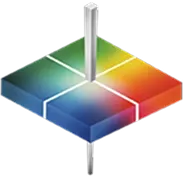
Many variables affect color and visual appearance. Light, angle, and/or background all affect visual analysis and cause major variations in color perception. Image Source: Daniel Christensen via wikimedia.org
The human eye is a remarkable tool in identifying color variations. In fact, the human eye can actually distinguish over 7,000,000 different color variations in our known spectrum of colors. Science and technology have explored the eye-to-brain connection of how light is absorbed and reflected, and these results have shown that the human eye is capable of distinguishing even the slightest deviations in color.
Despite how amazingly accurate and complex human vision can be, the eye and the brain do have their limitations. Optical inputs of color variations are altered by a variety of causes that lead to problems with visual analysis, especially in plastic manufacturing. Manufactures have to be incredibly precise when creating their products, to account for the variations in the way we see things, and to mitigate against their negative effects. Spectrophotometry tools are incredibly useful in this process.
Limitations of the human eye
In the same way that no two people are alike, color perception also varies greatly from person to person. Color variations have also been noticed in many individuals between left-eye and right-eye differentiation. Even as you look at this screen, if you shut one eye and then alternate viewpoints with the other, you may notice the slight variations in color from your own unique perspective.
Though we all view colors in relatively the same way, our unique genetic make-up also plays an important role in how we differentiate between color variations. Just like any other physical ability or trait, vision varies in aptitude as well. It can range from highly effective to somewhat defective in its ability to classify color. From good to poor color vision or even color blindness, everyone has limitations when it comes to color analysis.
Take for instance the ability to see in the dark. The human eye is not able to distinguish color at all without some source of light. Even with minimal lighting, our brain will interpret color using only a limited scale of grey. It is certain that the human eye is a powerful tool, but despite its amazing competencies, we can see that there are a number of other factors that limit our abilities in perceiving color variations. Only with advanced spectrophotometric technology and controlled conditions can the brain accurately and consistently decipher variations in color.


